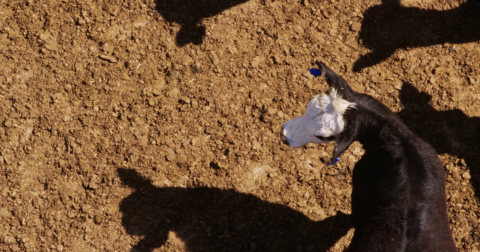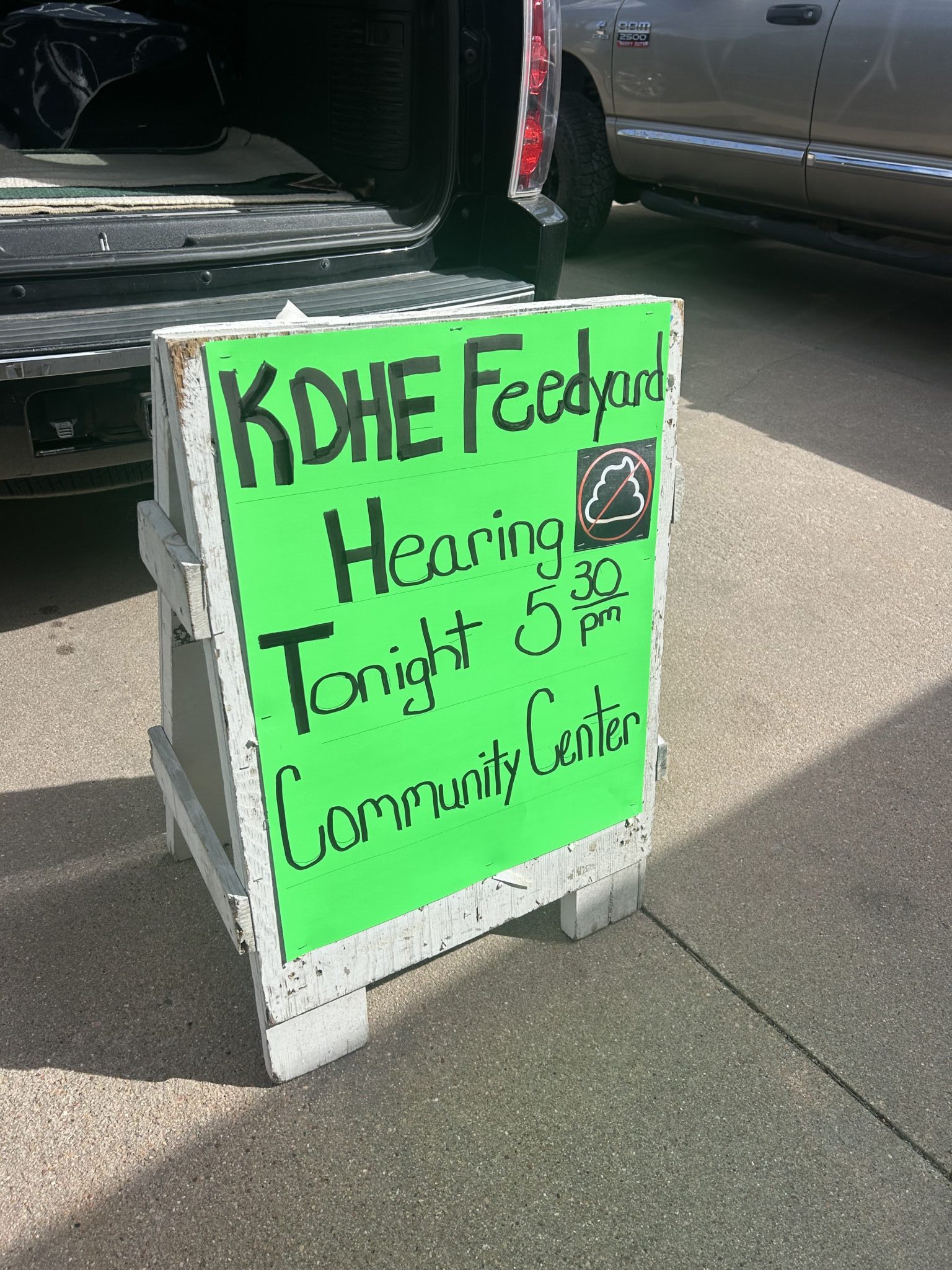Perspective
How Meat Became Cool Again in 2025
Diet•4 min read
Investigation
Despite community pushback over groundwater pollution and health risks, the 88,000-head feedlot will be one of the largest in the state.


Words by Nina B. Elkadi
Merrill Cauble grew up in the cattle industry, so he knows a little something about raising cows. In Pawnee County, Kansas, Cauble has witnessed what he calls a “deterioration” in the county as smaller farms have been swallowed by massive feedlots. When a realtor asked Cauble about selling his land to Innovative Livestock Services (ILS) for the company’s planned 88,000-head feedlot, he didn’t even think about it — no way would he sell his property to the very organizations he deems to be wreaking havoc on his state.
Depending on the direction of the wind, the dust from the feedlots will blow into town, where he lives now.
“When the cattle get to feeling good in the evening, they go moving around, and they stir up the dust and manure,” he tells Sentient. The stench has become a part of life in Larned, Kansas. “The town stinks enough the way it is.”
The feedlot, according to a document obtained by Sentient through a public records request, will be less than a mile from Cauble’s home. Innovative Livestock Services estimates that the feedlot will produce approximately 588,000 pounds of manure each day, a figure which has residents concerned about not only the stench, but water pollution caused by nitrates leaking from the manure.
The addition of this feedlot would more than double the total number of cattle in the area, which is currently 72,000. Cauble says Pawnee County residents are already suffering the consequences in their air and water. Nitrate levels in the groundwater below one of the existing ILS feedlots have measured as much as six times the Environmental Protection Agency’s safe drinking water standard. High nitrate levels are linked to higher risk of colorectal cancer, and can cause a condition with dangerously low blood oxygen levels in babies six months and younger.
Cauble and another Pawnee County resident, Felix Revello, helped to form “Pawnee Citizens Advocating for Rural Environment and Economy,” an advocacy group working to stop the feedlot. They have written to the governor and mobilized residents to raise their concerns to the Kansas Department of Health and Environment (KDHE). “The feedlot would add stress to a water system that is already burdened by drought and overuse,” reads one such comment. “Residents in the area would be subjected to environmental impact ranging from uncomfortable to dangerous.”

Despite their efforts, the permit for the new feedlot was approved.
In their final determination on August 5, the Department of Health and Environment wrote that living conditions and “general issues related to ‘quality of life’” are not within their purview. Any existing groundwater issues, such as nitrate pollution, “are considered independent” of this permit. Because this facility is new, despite being owned by the same company as nearby feedlots, it is “not responsible for any pre-existing contamination.”
Innovative Livestock Services Inc. is a cattle operation that owns hundreds of thousands of cows across nine feedyards in Kansas and Nebraska, as well as land used to grow their feed, including alfalfa, corn, soybean and wheat.
The feedlot in Larned, Kansas, will be an 88,000-head feeder cattle operation, consisting of “open lots of pens” across 640 acres.
Ninety-nine percent of farm animals in the U.S. are raised in factory farms, often raised in Concentrated Animal Feeding Operations (CAFOs), with little room to move about. This feedlot, built for 88,000 cows, will have a population 24 times bigger than the nearby town of Larned and dwarf other ILS feedlots in the area, such as Ward Feed Yard Inc., which has 22,600 animals, and Ward Feed Yard South, which has 25,700 cattle. It will be one of the largest feedlots in the state.
According to their Nutrient Management Plan, the feedlot will produce approximately 107,400 tons of manure annually, or around 214 million pounds, enough to fill 39 Olympic-sized swimming pools. All this solid waste can be exported to farms owned by Innovative Livestock Services, where according to state regulations it can be applied as fertilizer without the need for groundwater monitoring. Manure from two of the existing ILS feedlots in town are exported to ILS Farms, according to documentation reviewed by Sentient.
The proposed feedlot is located on top of the Great Bend Prairie Aquifer, defined by the Kansas Geological Survey as a “sensitive groundwater area.” “They’re putting all these cows over a very permeable soil structure that lies over an ancient sand dune,” Craig Volland, the Kansas Sierra Club Agriculture Chair, tells Sentient. Wastewater could easily seep through this soil and sand into nearby drinking water wells. Volland and the Sierra Club submitted multiple comments and petitions against the feedlot, too, citing the high risk to Pawnee County’s groundwater, and the Department of Health and Environment’s job to “minimize risks to public health.”
In 2022, nitrate levels in the groundwater below one of the ILS facilities were as high as 62 parts per million, over six times the Environmental Protections Agency’s safe drinking water standard of 10 parts per million, according to documents reviewed by Sentient. Nitrate pollution in drinking water is the result of agricultural runoff from synthetic or natural fertilizers (manure).
The EPA warns parents not to use water with nitrate levels over 10 parts per million to mix babies’ formula. Exposure to nitrate pollution at only 5 parts per million or above is consistently linked to a higher risk of colorectal cancer, according to a state fact sheet from the University of Iowa Environmental Health Sciences Research Center.
Residents like Revello and Cauble worry that because the groundwater in Pawnee County is so close to the Earth’s surface, nitrate levels in their drinking water could soar even further from the new feedlot. Acute nitrate exposure is especially high-risk for babies, who can develop blue-baby syndrome, which makes it harder for their blood to carry oxygen and, if untreated, can be fatal.
At a community hearing about the proposed feedlot on March 25, 2025, Larned resident CT Taylor told KDHE that he wants his nine-year-old child to “be healthy and be able to move and thrive in his life.” There is already a feedlot just north of his residence, and Taylor, who recently received a heart transplant, says he has nitrate-laden water coming out of his tap. In a letter to the Department of Health and Environment, Tayor wrote that he cannot afford a filtration system.

“I go into town two to three times, and, if people let me, four to five times a week, just to take a shower. I cannot drink my water, I do not shower with my water,” he said at the hearing. “If this goes in, it’s going to become very detrimental, not only for myself, but also for anyone else that’s within that area. It’s going to be even worse for those who are closer.”
Cauble and Revello circulated a map of local nitrate pollution levels at an annual community gathering called Santa Fe Trail Days. “People looked at me and said, ‘Well, we live right over here,’” Cauble recalls. “Before we started this whole deal, I don’t think people realized how bad the nitrate pollution was.” At the event, they collected 51 signatures opposing the feedlot, which they later hand-delivered to Kansas Governor Laura Kelly’s office.
Cauble and Revello pursued independent testing of Pawnee County residential well-water at the University of Nebraska, and the scientists at the lab confirmed that the nitrate contamination in that water was from animal manure.
However, the Kansas Department of Health and Environment maintains in its determination that “existing groundwater quality issues are considered independent of the ILS Permit.”
ILS did not respond to requests for comment
In the summer of 2024, Cauble attended the county commissioner meeting to ask about the feedlot plans. He claims the county commissioner told him the project was “pretty much a done deal,” months before the feedlot even applied for a permit. Mike Burdett, Pawnee County Commissioner for District 1, wrote to Sentient that while he cannot comment specifically on that claim, he speculated that “someone maybe made a comment about the county having no say and someone else interpreting that to mean it was a ‘done deal.’”
In November 2024, the permit was officially filed. Just over two months later, the Kansas Department of Health and Environment approved the construction plans.
On January 9, 2025, Revello requested a public hearing regarding the feedlot. In Kansas, public hearings for new CAFOs are not required unless a resident requests one, explains Charline Whyte, a staff attorney at the Socially Responsible Agriculture Project, a non-profit advocacy group focused on protecting communities from factory farms.
The hearing was held on March 25, 2025, and in the weeks leading up to it, KDHE’s inbox was filled with public comments. Though the feedlot is expected to bring around 70 new jobs to the county, Pawnee County residents Michael Gore and Betsy Crawford-Gore wrote in their comment that “there have been many times I have heard people who are employed here who refuse to live here due to the current feedlot odor and dust (even after the remediation efforts).” According to census data, Pawnee County, Kansas, has been steadily losing population since 1973.
At the hearing, which attracted more than 200 residents, Cauble said that KDHE’s job, according to their own website, was to protect the health of Kansans, “not the financial interest of multi-million-dollar corporations.”
But the department upheld the permit, writing that they do not have the authority to evaluate the feedlot’s impact on “living conditions” or “general issues related to ‘quality of life.’” KDHE did not respond to requests for comment.
Even with a coordinated effort, residents often find themselves navigating a broken system.
“Very little stands in the way of approving a feedlot, and that is the problem,” Whyte says. “The current law wasn’t designed for these mega CAFOs, and this newly permitted 88,000 head facility in Pawnee County underscores that gap.”
In an email to Sentient, Revello wrote that, most disappointingly, the group has yet to hear from Kansas Governor Laura Kelly, despite her establishing a “water program task force” to investigate water quality issues just months ago. The Governor’s office did not respond to requests for comment.
A final determination on the permit does not necessarily mean the case is closed, Whyte adds.
“There’s definitely value when people speak up,” she says. Revello, Cauble and Volland used the Freedom of Information Act to request documents from the state and learn what was happening behind the scenes, and they can continue to do so as the feedlot is operating.
Although the feedlot was approved, extra conditions were added to the manure storage plan in an attempt to add more safeguards against water pollution. Volland explains that Innovative Livestock Services agreed to a tighter standard that reduces how much wastewater is allowed to leak from the manure lagoon each day. The facility will be required to monitor groundwater and provide those results to the Department of Health and Environment annually. However, Volland notes that since that manure is likely to be exported, monitoring should also be required where the manure is applied. The work of the “feedlot fighters,” made these changes to the permit possible, Volland says.
“It is a real duty, a mission, to fight this type of development which only serves to pollute the environment of rural Americans and impoverish their communities,” Revello says. “All the profits are siphoned away from our economy.”
“We cannot pollute our way to prosperity,” Revello wrote to Sentient. He wrote that the stench and water pollution from feedlots drive away potential new residents that the rural community badly needs. “Local residents joke about the ‘smell of money’ coming from feedlots, but we all know that it’s really the stench of poverty and sickness.”